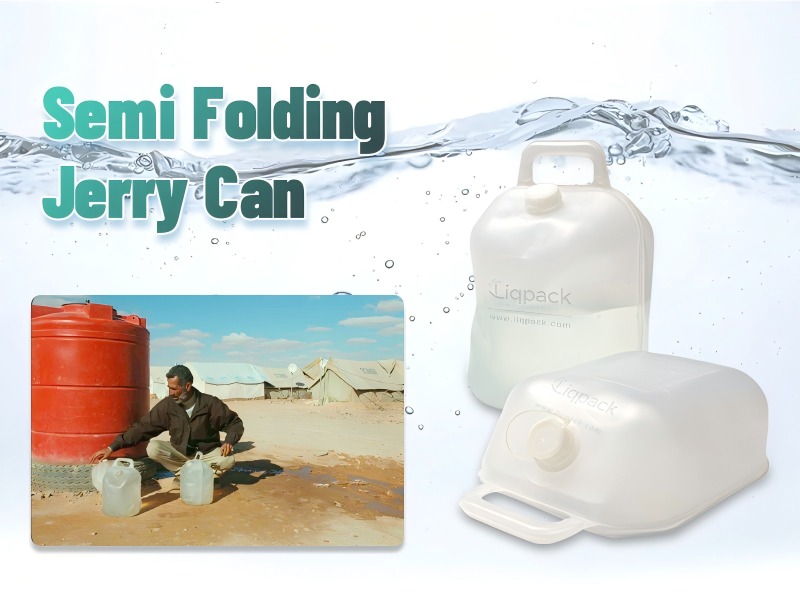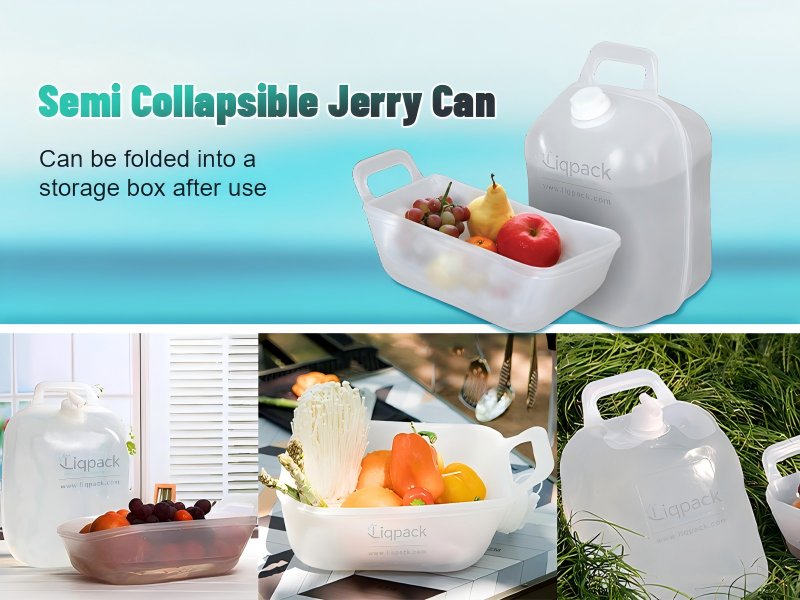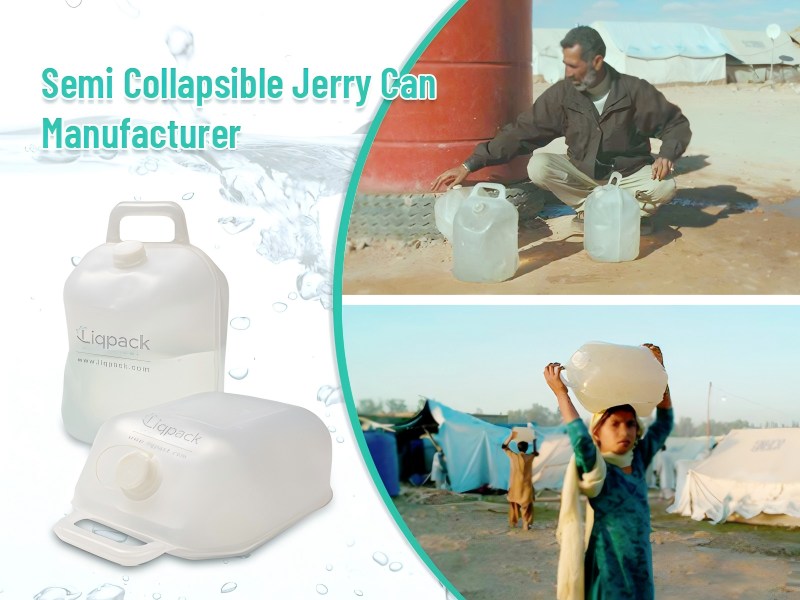
Cubitainers are compact, collapsible liquid containers combining a flexible inner bag with a durable outer shell. Lightweight and space-saving, they’re widely used in pharmaceuticals, chemicals, food, and emergency supplies. Available in 5L, 10L, 20L, and 1000L sizes, each offers unique advantages. This article compares them to help you choose based on scale, handling, and cost.
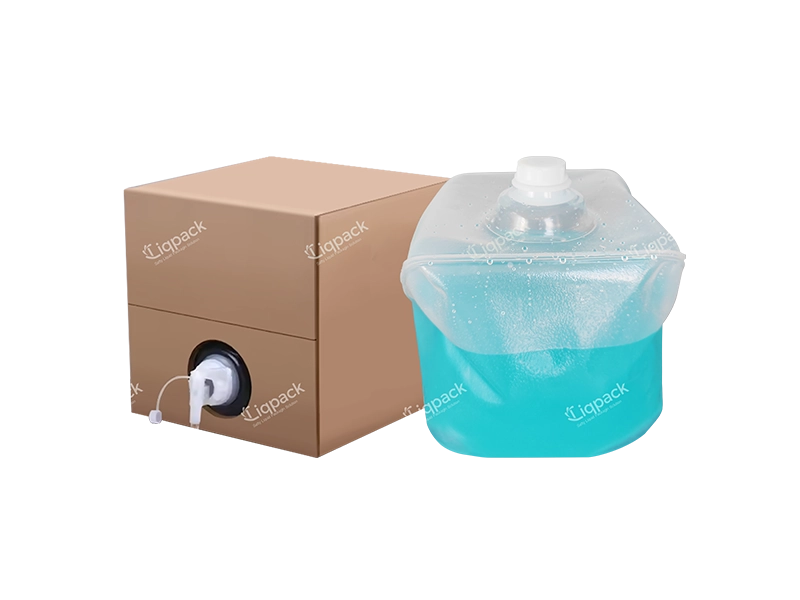
What Is a Cubitainer?
A Cubitainer is a combination of a collapsible polyethylene inner container and a supporting outer carton or rigid case. The inner bag is made of LDPE or other food-grade plastics, often featuring a screw cap or dispensing spout. When filled, it provides the structure and security of a rigid container. When empty, it can be folded down flat, minimizing waste and storage space.
Size Comparison Overview
| Cubitainer Size | Common Use Case | Net Weight Capacity | Typical Dimensions | Advantages |
| 5L | Household use, small-scale sampling | ~5kg | ~190 x 190 x 190 mm | Ultra-portable, compact, and easy to store |
| 10L | Laboratory, field use, low-volume chemicals | ~10kg | ~250 x 250 x 250 mm | Balance of volume and portability |
| 20L | Food-grade liquids, reagents, and solvents | ~20kg | ~300 x 300 x 300 mm | Industry standard, stackable |
| 1000L | Bulk liquids, industrial and commercial use | ~1000kg | ~1200 x 1000 x 1150 mm | Maximum efficiency reduces packaging waste |
5L Cubitainer: For Precision and Portability
Ideal for:
- Lab reagents and small-scale testing
- Specialty chemicals
- Travel and mobile operations
- Sample distribution
Advantages:
- Lightweight: At just 5 liters, this is easy to carry by hand.
- Compact design: Fits in small spaces—under sinks, in toolkits, or lab shelves.
- Lower cost: Both product and shipping expenses are minimized.
- Convenient dispensing: Typically comes with a small spout or screw cap for precise pouring.
Limitations:
- Not suitable for large-scale or high-volume needs.
- Requires frequent replacement or refilling for industrial use.
Best Use Cases:
- A medical lab is transporting a sterilizing solution.
- An outdoor sports company offering hydration concentrates in small packs.
- Cosmetic firms are supplying hair colorant components in small portions.
10L Cubitainer: The Versatile Middle Ground
Ideal for:
- Medium-volume chemical packaging
- Pharmaceutical production
- Specialty food ingredients
- Water sampling
Advantages:
- Balance of size and manageability: Still portable by hand, but holds double the capacity of a 5L.
- Reduces handling frequency: Refill intervals are longer.
- Good for dual-use packaging: Can work in both consumer and commercial contexts.
- Flexible storage: Stacks well in warehouse environments or mobile service vehicles.
Limitations:
- Still not enough volume for full-scale industrial operations.
- It might not be economical for very large customers who need to package in volume.
Best Use Cases:
- A diagnostic reagent manufacturer sending 10L supplies to hospitals.
- A water purification firm offering liquid concentrates in this size for distributor-level users.
- Industrial cleaning suppliers selling pre-measured 10L cubitainers of cleaning agents.
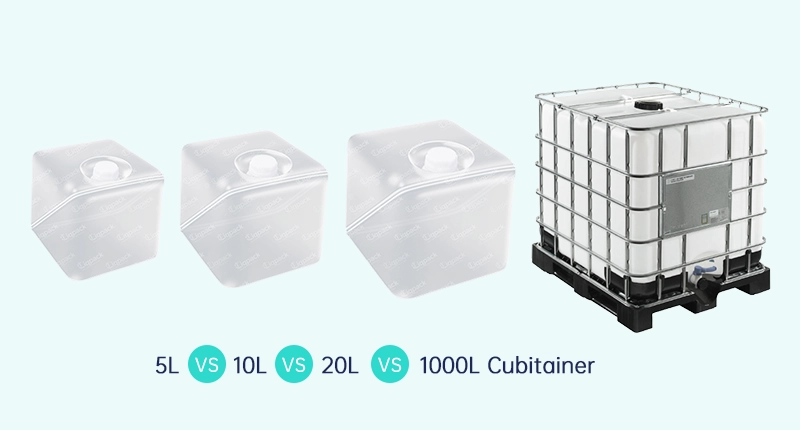
20L Cubitainer: The Industry Standard Workhorse
Ideal for:
- Industrial chemicals
- Food processing liquids
- Agricultural solutions
- Hemodialysis reagent storage
Advantages:
- Widely accepted size in industrial and commercial distribution.
- Efficient per liter cost for packaging and shipping.
- Compatible with dispensing systems: Pumps and spigots work well with this format.
- Stackable and space-efficient: Outer cartons often designed for palletized shipment.
Limitations:
- May be too bulky for small-scale use.
- Requires moderate lifting capacity (20kg+ when full).
Best Use Cases:
- Chemical suppliers shipping surfactants, acids, or oils in 20L units.
- Food production facilities storing soy sauce, vinegar, or flavoring agents.
- Medical companies packaging dialysis concentrates.
Why It’s Popular:
The 20L cubitainer hits the sweet spot for many businesses. It’s large enough for meaningful volume, yet manageable enough to carry, pour, or store without special equipment.
1000L Cubitainer (IBC Format): Bulk Power in a Box
Also known as: IBC (Intermediate Bulk Container)
Ideal for:
- Large-scale industrial operations
- Bulk storage of lubricants, chemicals, or water
- Disaster relief water supply
- Agriculture: fertilizers, crop sprays
Advantages:
- Maximum volume: Reduces container waste, handling time, and shipping costs per liter.
- Reusable or disposable: Can be refilled depending on design.
- Integrated with forklifts and pallet jacks: Made for efficient warehouse use.
- Durable construction: Comes with a steel frame and often UV-protected tanks.
Limitations:
- Heavy equipment required: Cannot be moved or lifted manually.
- High upfront cost: More expensive per unit, though cheaper per liter.
- Not suitable for mobile or lightweight operations.
Best Use Cases:
- A water bottling company receiving bulk purified water for packaging.
- A paint manufacturer storing solvents or binding agents.
- Emergency agencies setting up a water supply system in disaster zones.
Application Comparison Table
| Application Area | Recommended Cubitainer Size | Justification |
| Household Cleaning Products | 5L–10L | Small usage, light and easy to store |
| Laboratory Testing | 5L–10L | Ideal for reagent or sample packaging |
| Food Ingredient Storage | 10L–20L | Enough volume for food prep, compact storage |
| Agricultural Chemicals | 20L–1000L | High usage requires larger formats |
| Disaster Relief Water Supply | 20L–1000L | Needs to be compact (20L) or large-scale (1000L) |
| Industrial Chemical Supply | 20L–1000L | Depends on production size and refill frequency |
Storage and Transport Considerations
Stackability: 5L, 10L, and 20L cubitainers are often designed to be stacked in layers for storage and transit.
Palletization: 1000L containers are compatible with forklifts and typically stored on pallets.
Regulatory Compliance: For hazardous materials, all sizes must comply with UN/DOT or FDA guidelines as applicable.
Secondary Packaging: Smaller cubitainers may require external cartons for retail display or shipping.
Sustainability and Cost Efficiency
Cubitainers are inherently sustainable compared to rigid plastic drums:
Less material usage: Inner bags use less plastic overall than fully rigid containers.
Flat storage after use: Reduces transportation volume on return trips.
Lower carbon footprint: Fewer trucks needed for the same liquid volume compared to barrels or bottles.
Recyclable materials: Many cubitainers are made from recyclable LDPE.
| Size | Approximate Empty Weight | Plastic Material Savings vs. Rigid |
| 5L | ~150g | 60–70% less plastic |
| 10L | ~250g | 50–60% less plastic |
| 20L | ~400g | 40–50% less plastic |
| 1000L | ~50kg | Integrated cage + liner, reusable |
These reductions, when applied to large volumes, lower operating expenses and support company sustainability objectives.
Conclusion: Matching Size to Purpose
When choosing between 5L, 10L, 20L, and 1000L cubitainers, there’s no one-size-fits-all solution. Your application requirements, storage capacity, handling resources, and financial constraints will all influence the best choice.
- Opt for 5L or 10L if you need portability, sampling, or consumer-scale packaging.
- Choose 20L for mid-sized commercial or industrial use, especially if you want a balance between convenience and volume.
- Go with 1000L for bulk handling, long-term storage, or high-volume manufacturing.
Each cubitainer size offers its own advantages in durability, efficiency, and sustainability. By selecting the right size for your operations, you can optimize logistics, minimize waste, and enhance operational safety and economy.
Whether you’re a chemical manufacturer, food processor, or humanitarian agency, understanding these distinctions ensures your liquid packaging is as efficient and effective as your products themselves.
- Liqpack

